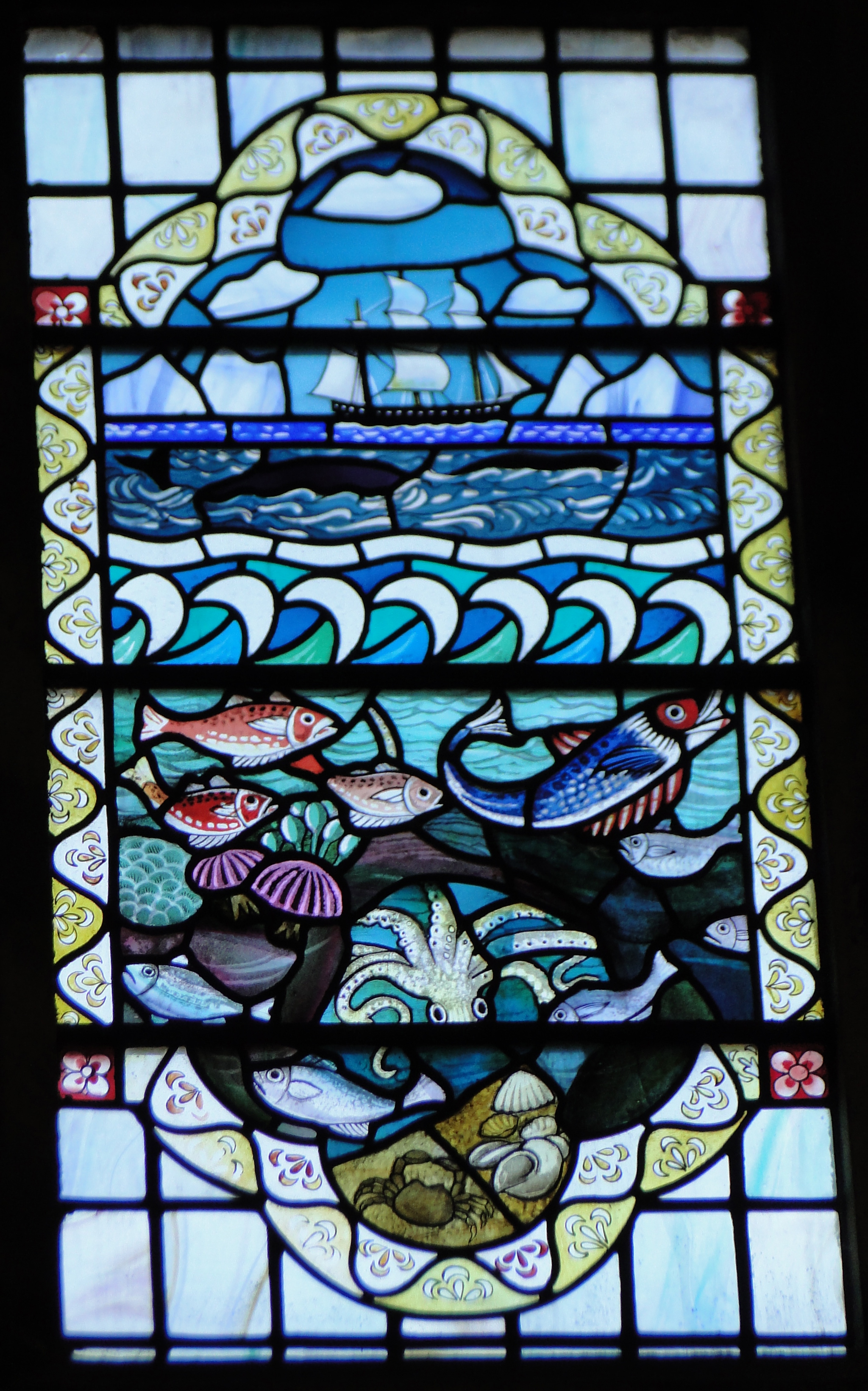A Monday morning date to welcome a new Area Dean – Nick Darby, who looks like a vicar ought to look. He is Vicar of St James and St Basil in Fenham (NZ226655), so it was an opportunity to take the camera and do a blog. A communion service with Bishop Martin, but the acoustics are so bad that those of us sat outside the chapel struggled to hear – an opportunity to study the glass (look upwards and you’re bound to look holy!).  The church was built in 1931 by Sir James Knott, in memory of two of his two sons, Major James Leadbitter Knott DSO and Captain Henry Basil Knott, who were killed in the Great War. Sir James himself was born in 1855 and left school at 14 to work as a shipping clerk on Newcastle Quayside. By 19 he was a shipbroker, owned his first ship at 23, by 31 had seventeen ships, and set up Prince Line Ltd in 1895. Eventually it was the third largest shipping company in the world. He sold the company after the death of his sons, and seems to have retired to Jersey. His wife died in 1929, when he was 74 – three years later he married a 25 year old – and died two years later. There is a lot of information about him at www.knott-trust.co.uk/knott-family-history.
The church was built in 1931 by Sir James Knott, in memory of two of his two sons, Major James Leadbitter Knott DSO and Captain Henry Basil Knott, who were killed in the Great War. Sir James himself was born in 1855 and left school at 14 to work as a shipping clerk on Newcastle Quayside. By 19 he was a shipbroker, owned his first ship at 23, by 31 had seventeen ships, and set up Prince Line Ltd in 1895. Eventually it was the third largest shipping company in the world. He sold the company after the death of his sons, and seems to have retired to Jersey. His wife died in 1929, when he was 74 – three years later he married a 25 year old – and died two years later. There is a lot of information about him at www.knott-trust.co.uk/knott-family-history. 

 There is a good piece about both James and Basil at Bob Coulson’s website www.fylde.demon.co.uk/coulson2.htm. James was educated at Eton, then travelled in the USA, before joining the Northumberland Fusiliers, then transferring to the West Yorkshire Regiment and going to France. He had had political ambitions before the War and, in 1916, was invited to contest the Hyde seat in Cheshire. He replied that “Party politics were of little significance at that time and … his duty was in France.” He was one of 700 British soldiers who died on 1 July 1916 at the start of the Battle of the Somme – and he was buried with many of his men at Fricourt Military Cemetery. Basil was nine years younger than his brother, and followed him through Eton. He joined the Northumberland Fusiliers and travelled to France on 15 July 1915. On 6 September he received a bullet to the head and died in the Casualty Clearing Station at Remy Siding the following day. He was buried at Lijssenthoek Military Cemetery. After the War Sir James used his influence to have his two boys buried next to each other at Ypres Reservoir Cemetery.
There is a good piece about both James and Basil at Bob Coulson’s website www.fylde.demon.co.uk/coulson2.htm. James was educated at Eton, then travelled in the USA, before joining the Northumberland Fusiliers, then transferring to the West Yorkshire Regiment and going to France. He had had political ambitions before the War and, in 1916, was invited to contest the Hyde seat in Cheshire. He replied that “Party politics were of little significance at that time and … his duty was in France.” He was one of 700 British soldiers who died on 1 July 1916 at the start of the Battle of the Somme – and he was buried with many of his men at Fricourt Military Cemetery. Basil was nine years younger than his brother, and followed him through Eton. He joined the Northumberland Fusiliers and travelled to France on 15 July 1915. On 6 September he received a bullet to the head and died in the Casualty Clearing Station at Remy Siding the following day. He was buried at Lijssenthoek Military Cemetery. After the War Sir James used his influence to have his two boys buried next to each other at Ypres Reservoir Cemetery.
St James and St Basil’s church was erected in Fenham, at that time a very prosperous suburb of Newcastle. James the Great has the cockle shell as his emblem, Basil (who was Bishop of Caesarea 370-9) wrote a treatise on the Holy Spirit and therefore has a dove as his symbol. The architect of the church was Edward Eric Lofting, Assistant Surveyor to the Fabric of Westminster Abbey, and the building is one of the great Arts and Crafts churches – “a masterpiece” to quote the guide. 



It is quite stunning – very tall – with some marvellous woodwork. Shame about the grotty chairs.
The windows are by Edward Woore – and they are lovely. I could have done with a cherry picker to get up on a level with them! The Adam and Eve window (with their children) also has a devil.
I went back on Thursday 20 October to enjoy Choral Evensong sung by the choir of Dame Allan’s Schools. Walmisley in D minor and Bob Chilcott’s Irish Blessing. Thanks Nick and Dana for your welcome.






